Jodi DeJong-Hughes, a soil health and tillage educator with the University of Minnesota, says it’s important to consider carbon when building healthy, sustainable soils.
“Anything that has been living or is living has carbon in it,” DeJong-Hughes says. “Carbon is life.”
Carbon is not just present in organic matter. Anything made from previously living things is also rich in carbon. The most common derivative being petroleum products, which include plastics, oil and gasoline, asphalt, clothing and countless other synthetic materials.
Across the Earth, carbon is stored in varying amounts in the ocean, soil, atmosphere and deep underground in the form of fossil fuels. When extracting those fossil fuels, excess carbon gets released into the air and can disrupt normal atmospheric processes.
This can create unusual weather phenomena, which crops must respond to. According to DeJong-Hughes, building resilient soil allows farmers to better manage changing conditions.
“Resiliency means that you can have drought conditions, but your crop is OK,” DeJong-Hughes says. “That you can have too much water, but it gets down into the soil quickly. That your field can rebound from changes in the climate right now.”
Benefits of Organic Matter
Soil that is naturally healthy and resilient needs organic matter, which is 58% carbon. Because the first 6 inches of topsoil holds 2,400 gigatons of carbon, even soil that is just 1% organic matter will have about 11,000 pounds of carbon per acre. However, higher percentages of organic matter, and therefore carbon, lead to healthier soils and better yields.
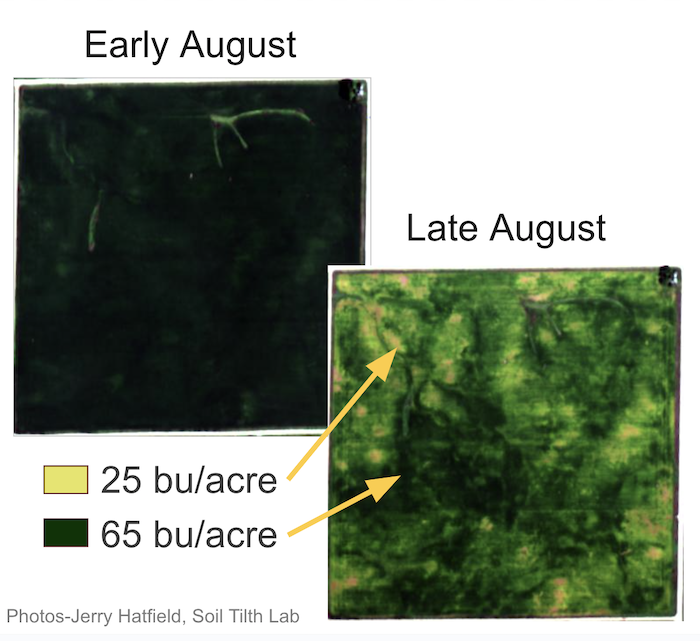
CARBON IMAGING. A Soil Tilth Lab study in Ames, Iowa shows the same soybean field at the beginning and end of August, demonstrating how carbon content affects yield.
This graphic shows an Iowa soybean field in early August vs. late August. The areas with a higher percentage of organic matter generated 65 bushels per acre instead of 25 bushels per acre. The dark green color represents the carbon present in the soil and how it’s depleted over the course of a month. This difference in organic matter affects the soil’s ability to properly manage moisture and supply the crop with nutrients.
“You can see it in the soil,” DeJong-Hughes says. ”If you have soil that’s a rich black color, you could have 4-6% organic matter. If it is really light in color, you are down to less than 1% organic matter. “And you know that because these are the areas that burn up first. These are the ones that need more water and more babying.”
However, even in areas with a relatively small amount of organic matter, there are massive amounts of nutrients. DeJong-Hughes says there is about 1,000 pounds of nitrogen (N), 100 pounds of phosphorus, 100 pounds of potassium and 100 pounds of sulfur per percentage of organic matter. To put this into practical terms, if the soil did not supply any of these nutrients, it would have cost $1,300 per acre to buy the nutrients in just 1% organic matter in 2022.
Because these nutrients are so valuable, DeJong-Hughes stresses the importance of building carbon naturally, not only to protect crops, but to protect farmers’ wallets as well.
“Have you had the year where you fertilized for 180 bushels, but you got 230, and you’re like, wow, how do I have enough N for that?” DeJong-Hughes says. “It’s coming from your organic matter. The microbes are helping you out.”
The higher the percentage of carbon organic matter in a field, the healthier, more resilient and more cost efficient a crop is.
Carbon Banking
As carbon cycles through the field, there are events that remove carbon and ones that add carbon. Tillage, for example, removes carbon, while implementing cover crops adds biomass and therefore carbon.
“I like to equate carbon to a bank,” DeJong-Hughes says. “You have your deposits, and you have your withdrawals, and you want to make sure that your account is building. You can manipulate these.”
The carbon cycle starts with photosynthesis. This is the process by which plants make their own food by taking the energy from sunlight, carbon dioxide and water to make sugar.
While this helps the plant grow and increases its own carbon content, 30% of the carbon is leaked into the soil as food for microbes. Those microbes take in the carbon and respire carbon dioxide for the plant. Though harvesting removes much of the carbon from the soil through microbial respiration, the remaining crop residue is 45% carbon, which helps resupply the field’s carbon bank.
“Farmers often think, if organic matter is 50% carbon and residue is almost 50% carbon, if I till my residue into the soil, I’m putting it where it needs to be to build organic matter,” DeJong-Hughes says. “Intuitively that makes sense, but that’s not what happens.”
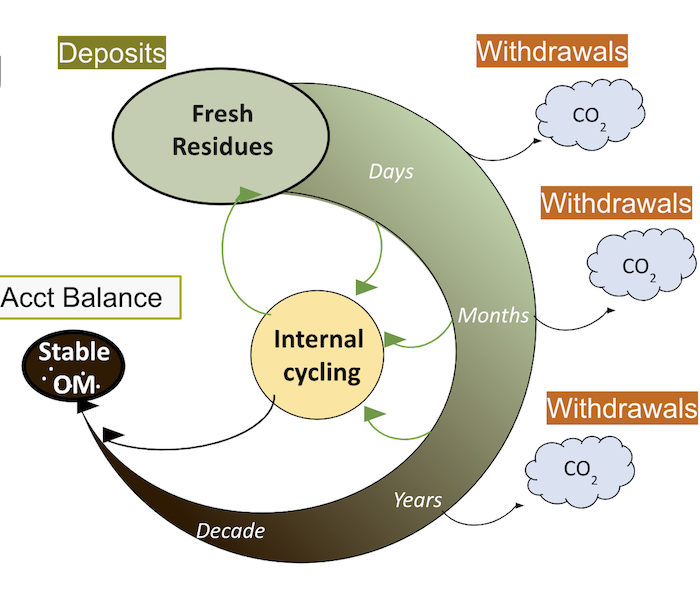
RESIDUE CYCLE. The carbon content of crop residue is consumed by microbes in the soil, which is then respired off as carbon dioxide. Only 1% of crop residue becomes stable organic matter.
Instead, the microbes that already exist in the soil intercept that carbon from crop residue and respire it off as carbon dioxide. Only about 1% of fresh residue makes it to stable organic matter because of the carbon cycling of plants, microbes and weather conditions.
DeJong-Hughes says this means that the process of building up organic matter to a point where it is noticeably advantageous to the crop is a years-long process that requires patience and good farming practices.
There are several factors that contribute to carbon withdrawals, and DeJong-Hughes says the main one is heavy tillage. Tillage disrupts organic matter, freeing up oxygen and nutrients previously unavailable to microbes, which take them in and then release carbon dioxide, leaving nothing for the soil. The amount of carbon lost through microbial respiration is dependent on how often and aggressively the soil is tilled, according to DeJong-Hughes.
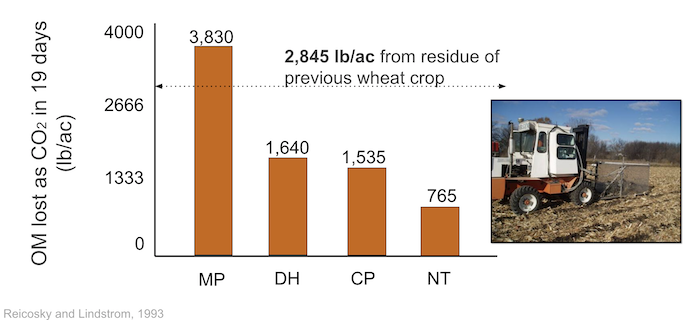
TILLAGE EFFECTS. Previous crops add a measurable amount of carbon to soil, which is then removed in varying quantities by different tillage methods.
A carbon study in Minnesota measured organic matter in pounds per acre lost as carbon dioxide over the course of 19 days, comparing moldboard plow, disc harrow, chisel plow and no-till. The previous wheat crop provided 2,845 pounds of organic matter residue, and moldboard plowing, the most aggressive tillage method, caused the loss of 3,830 pounds of carbon dioxide per acre, leaving the soil in a carbon deficit. Less tillage, however, maintained a carbon surplus within the soil.
Withdrawals vs. Deposits
When depositing into your carbon bank, manure, biomass and cover crops help balance out withdrawals.
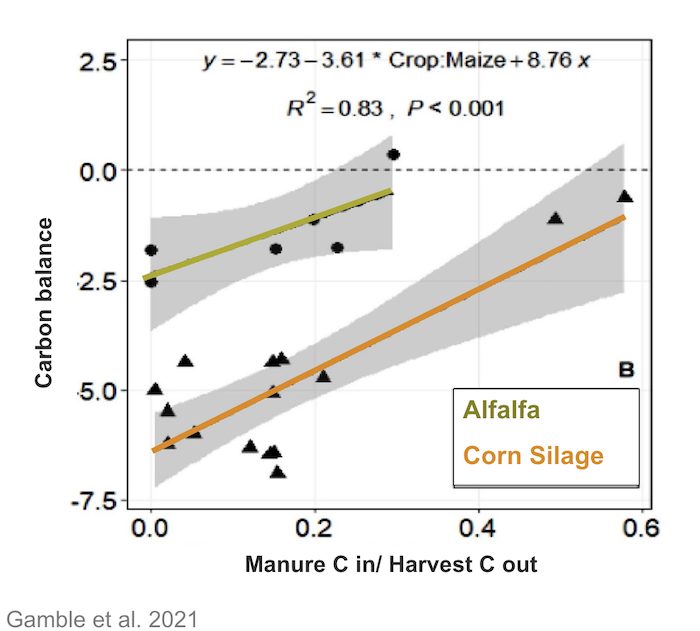
CARBON BALANCE. Manure application builds biomass, helping a field’s carbon balance return to 0 instead of maintaining a deficit from harvest.
A 2021 Minnesota study looked at the carbon balance of corn silage and alfalfa when adding manure as fertilizer. The researchers found that the more manure that was added, the closer they got to a carbon surplus.
“Even if you’re not getting a positive response, it’s better than losing a lot,” DeJong-Hughes says, emphasizing the need to take little steps towards a bigger goal.
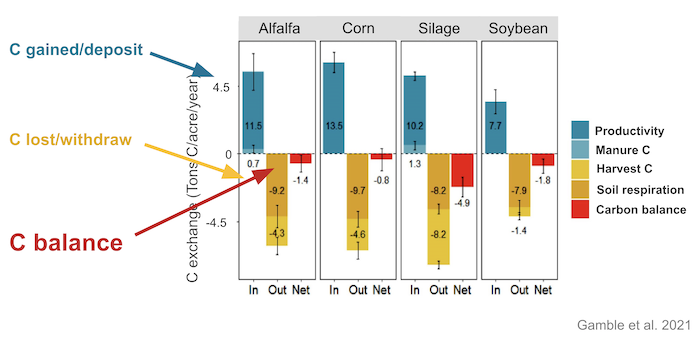
BUILDING CARBON. While carbon is removed from a field by harvest and soil respiration, it can be added through biomass and healthy soil biology. Overall carbon balance can be manipulated through farming practices.
Another 2021 study compared 9 years each of planting alfalfa, corn, silage and soybeans to determine which crops are providing the most or least net carbon. Silage, for example, takes considerably more carbon from the soil than it deposits. Though manure application contributed to positive carbon, soil respiration and harvest took even more away. DeJong-Hughes says these are important factors to consider when analyzing your field’s carbon footprint and overall health of your soil, but this data should not be a deterrent from a diversified rotation.
“We don’t just manage for carbon. We manage for disease and weeds and everything else,” DeJong-Hughes says. “What this is saying is that this is a great place to put more manure and put in a cover crop to get more carbon. We can manipulate that red line. We can start pushing it up higher.”
Implementing cover crops in addition to utilizing manure as fertilizer will help deposit more carbon in a field’s bank. Not only does it capture carbon, but it also helps build soil structure and adds biomass. DeJong-Hughes says anything that contains carbon and can feed both crops and microbes is going to create valuable organic matter and help build soil resiliency.
Building Carbon Realistically
DeJong-Hughes has a straightforward solution to building carbon in a reasonable way, and it’s simply to pay attention to your soil health. She says the way to pay attention to soil health is to add as much organic matter as possible. Though this is a long and gradual process, taking the time to implement certain practices will pay off down the road. She offers these suggestions for building soil carbon:
- Reducing tillage by using less aggressive implements will keep soil intact so as not to disrupt the existing organic matter.
- Building up biomass will also build organic matter by keeping the soil covered and introducing additional carbon sources, which can include anything from manure to dead crop residue.
- Similarly, be aware of which crops have the highest carbon requirements so that more aggressive soil health practices can be used to maintain as much organic matter as possible.
Still, one size does not fit all. Climate differences between farms, equipment needs, current soil health and return on investment should all be considered when starting the process of building carbon.
“I don’t want to be the person saying, ‘But you’re not doing this practice,’” DeJong-Hughes says. “Instead, let’s keep looking at how to improve our soil because it will be a benefit to you now and later.”
Watch DeJong-Hughes’s presentation from the 2022 National Strip-Till Conference to learn more about carbon banking.
Related Content
How Crop Rotation & Microbial Management Practices Affect Soil Health
Encouraging Beneficial Insects for Better Soil Health and Higher Profits
Strip-Till Sequesters Carbon, Builds Soil Health






